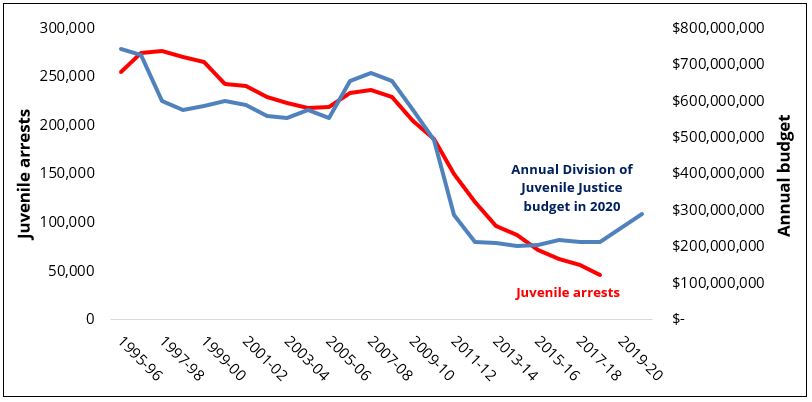![]() The massive, 82% plummet in youth arrests over the last quarter-century has devastated California’s youth correctional system, the Division of Juvenile Justice (DJJ). From 1996 to 2015, the number of youth confined in DJJ plunged from 9,800 to 700, eight of its 11 facilities closed, and its budget decreased by 72%. Similar trends are evident at the local level, where juvenile hall and camp populations have dropped by two-thirds during the same period.
The massive, 82% plummet in youth arrests over the last quarter-century has devastated California’s youth correctional system, the Division of Juvenile Justice (DJJ). From 1996 to 2015, the number of youth confined in DJJ plunged from 9,800 to 700, eight of its 11 facilities closed, and its budget decreased by 72%. Similar trends are evident at the local level, where juvenile hall and camp populations have dropped by two-thirds during the same period.

Mike Males
However, since 2015, DJJ’s budget has risen sharply, even as youth arrests have continued falling. Under Gov. Gavin Newsom’s fiscal year (FY) 2020-21 budget, state spending on DJJ will have soared by 40% since FY 2014-15. DJJ is now slated to spend $336,021 per incarcerated youth annually.
New ‘reforms’ could increase youth incarceration
How can California’s youth prison budget be exploding as juvenile crime sinks to all-time lows? Recent proposals, reversing past efforts to empty state facilities, now aim to rescue DJJ.
Newsom proposes to move DJJ from the Department of Corrections and Rehabilitation to the Health and Human Services Agency. The Legislature then allocated millions each year to fund so-called “therapeutic communities” within aging DJJ facilities. The Chief Probation Officers of California (CPOC) advocate raising the age of juvenile jurisdiction, infusing the dwindling juvenile system with thousands more 18- and 19-year-old adults.
CPOC dubiously credits probation officers and system personnel for applying “new science” to bring down juvenile crime. This “new science” is neither new nor science, nor does the system deserve credit. Young people themselves brought down crime by avoiding the system in the first place. In 1996, approximately 207,000 youths were referred to probation agencies; in 2018, just 38,000. Local juvenile detention bookings fell 10% in 2019, suggesting another big drop in youth crime. That’s why juvenile justice interests are scrambling for new adult clients.
While CPOC’s “raising the age” proposal and the governor’s plan to provide “therapeutic services” at DJJ sound good, these recent proposals are neither new nor necessarily benign. DJJ has been shuttled back and forth between prison and human services agencies repeatedly, and “therapeutic breakthroughs” surface every few decades, to little effect. The Legislative Analyst’s Office warns the governor’s plan promises few benefits and might even boost incarceration.

Source: California Department of Justice (2019); Legislative Analyst (2019). DJJ budgets provided by special request. Budgets are in constant, California-CPI-adjusted 2020 dollars. Note: Beginning in FY 2012-13, the DJJ budget total no longer includes parole expenses as this responsibility shifted to the counties after FY 2011-12.
.
The larger question is why progressive interests would want to save DJJ from a natural death, or at least radical transformation. Even after exhaustive court interventions, a 2019 report by the Center on Juvenile and Criminal Justice finds juvenile facilities remain rife with abuses, violence and little rehabilitation. Three-fourths of released youth are rearrested within three years.
Youth crime continues to drop amid state’s failings
The reduction in youth arrests has saved California some $7 billion in incarceration costs alone since 1996, with additional savings in police, probation, court and local costs. Had the state continued cutting DJJ’s budget in tandem with falling youth crime and closed more facilities, Californians could have saved hundreds of millions more dollars.
Does California have better uses for these billions of dollars than rescuing obsolete juvenile justice bureaucracies? Young people’s revolutionary plunge in crime calls for far bolder reforms than another round of agency and youth shufflings.
An opportunity for innovative reform
California is cursed with dire needs and blessed with abundant resources to innovate true reforms. A disgraceful 43% of the state’s youth live at or near poverty levels. Its students suffer $131 billion in education debt. Teenage unemployment approaches 18% (before the pandemic). Four in five youth arrests and five in six youthful gun killings occur in the state’s poorest areas.
Further, California’s environmental crises are mounting alarmingly. The state desperately needs trained workforces to manage wildfires, forestry fuel buildup, deteriorating flood control and water supply systems, energy conservation installations, $1.6 billion in deferred parks maintenance, and other climate change and environmental challenges.
The state imprisons some 13,000 adults and 300 youth designated as “low-security risks” and has 140 conservation and detention camps totaling 12,000 beds, which sit two-thirds empty. Current small-scale fire crews, education and professional training programs through CAL FIRE, the California Conservation Corps and related agency collaborations should be greatly expanded to meet the state’s needs for environmental support and social services.
The billions of dollars saved by massive declines in youth crime present an opportunity for the state to invest in a large-scale conservation corps that would employ tens of thousands of civilians and incarcerated individuals for firefighting and environmental work projects. Innovative reforms can provide what California badly needs and what younger generations have made possible through record-setting crime declines.
Mike Males is senior research fellow for the Center on Juvenile and Criminal Justice in San Francisco. He is author of “Teenage Sex and Pregnancy: Modern Myths, Unsexy Realities.”

Judge Teske, thanks for your comments! You have long been an articulate voice for humane treatment of young offenders rather than the punitive approaches of the past. The juvenile justice system is now faced with revolutionary opportunities afforded by the massive plunge in youth arrests, just as larger society is faced with unprecedented challenges wrought by climate change. We need to look to young people, both those in the system and outside, as a crucial resource whose education, training, and employment to rescue the planet may prove the most effective means of justice-system reform as well.
I wholeheartedly agree Mr. Males. Here in Georgia our juvenile arrests have plummeted 60% since 2008 yet the state’s juvenile justice budget continues to increase. I have a column in the que that cautions practitioners not to put all their eggs in evidenced based programs. What many of youth need are the prosocial constructs that build their skillset for future success and to lift them out of Poverty, and your idea of dedicating these monies to building creating a conservation Corp hits the nail on the head. I am certainly a supporter of EBP’s but not at the expense of ignoring the reality that they are not effective in the face of the social circumstances many of these youth face almost every day to survive. EBP’s will not alone remove them from these circumstances. Its basic Maslow’s hierarchical needs. They can’t benefit from the EBP’s if they are stuck at the bottom struggling to survive. EBP’s will not put food on the table or a roof over their head, but what you are recommending will. And when that occurs, the risk of criminality is reduced. We must place more faith in our youth, and that begins with investing in them directly. Thanks for the column.